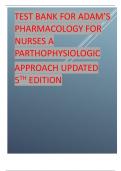TEST BANK FOR ADAM’S
PHARMACOLOGY FOR
NURSES A
PARTHOPHYSIOLOGIC
APPROACH UPDATED
TH
5 EDITION
,Chapter 1
Question 1
Type:
MCMA
The nurse is teaching a pharmacology class to student nurses. What does the nurse include as
key events in the history of pharmacology?
Note: Credit will be given only if all correct choices and no incorrect choices are selected.
Standard Text: Select all that apply.
1. Initial drugs included morphine, cocaine, and penicillin.
2. Early researchers used themselves as test subjects.
3. The initial intention of pharmacology was to relieve human suffering.
4. Modern pharmacology began in the early 1600s.
5. Pharmacologists synthesized drugs in the laboratory in the twentieth century.
Correct Answer: 2,3,5
Rationale 1: Initial drugs isolated from complex mixtures included morphine, colchicines,
curare, and cocaine, but not penicillin.
Rationale 2: Some early researchers, such as Friedrich Serturner, used themselves as test
subjects.
Rationale 3: The early roots of pharmacology included the application of products to relieve
human suffering.
Rationale 4: Modern pharmacology began in the early 1800s, not the 1600s.
Rationale 5: By the twentieth century, pharmacologists could synthesize drugs in the
laboratory.
Global Rationale: The early roots of pharmacology included the application of products to
relieve human suffering, and early researchers used themselves as test subjects. Initial drugs
included morphine, colchicines, curare, and cocaine, but not penicillin. Modern pharmacology
began in the early 1800s, not the 1600s. By the twentieth century, pharmacologists could
synthesize drugs in the laboratory.
,Cognitive Level: Applying
Client Need: Physiological Integrity
Client Need Sub: Pharmacological and Parenteral Therapies
QSEN Competencies: I.A.1 Integrate understanding of multiple dimensions of patient centered
care: patient/family/community preferences, values; coordination and integration of care;
information, communication, and education; physical comfort and emotional support;
involvement of family and friends; and transition and community.
AACN Essential Competencies: I.7 Integrate the knowledge and methods of a variety of
disciplines to inform decision making.
NLN Competencies: Knowledge and Science: Integration of knowledge from nursing and other
disciplines.
Nursing/Integrated Concepts: Nursing Process: Implementation
Learning Outcome: 1-1 Identify key events in the history of pharmacology.
MNL Learning Outcome: 1.1.1 Apply basic concepts related to pharmacology.
Page Number: 3
Question 2
Type:
MCSA
The student nurse asks the nursing instructor why he needs to take anatomy and physiology, as
well as microbiology, when he only wants to learn about pharmacology. What is the best
response by the instructor?
1. "Because pharmacology is an outgrowth of those subjects."
2. "You must learn all, since those subjects, as well as pharmacology, are part of the
curriculum."
3. "Knowledge of all those subjects will prepare you to provide the best patient care, including
the administration of medications."
4. "Because an understanding of those subjects is essential to understanding pharmacology."
Correct Answer: 4
Rationale 1: Pharmacology is an outgrowth of anatomy, physiology, and microbiology, but this
is not the most complete reason for the nurse to learn them.
Rationale 2: The nurse must learn anatomy, physiology, and microbiology to understand
pharmacology, not because they are part of the curriculum.
, Rationale 3: Knowledge of anatomy, physiology, and microbiology prepares the nurse to
understand pharmacology, not to provide care such as administration of medications.
Rationale 4: It is essential for the nurse to have a broad knowledge base of many sciences in
order to learn pharmacology.
Global Rationale: It is essential for the nurse to have a broad knowledge base of many sciences
in order to learn pharmacology. The nurse must learn anatomy, physiology, and microbiology to
understand pharmacology, not because they are part of the curriculum. Pharmacology is an
outgrowth of anatomy, physiology, and microbiology, but this is not the reason for the nurse to
learn them. Knowledge of anatomy, physiology, and microbiology prepares the nurse to
understand pharmacology, not to provide care such as administration of medications.
Cognitive Level: Applying
Client Need: Physiological Integrity
Client Need Sub: Pharmacological and Parenteral Therapies
QSEN Competencies: I.A.1 Integrate understanding of multiple dimensions of patient centered
care: patient/family/community preferences, values; coordination and integration of care;
information, communication, and education; physical comfort and emotional support;
involvement of family and friends; and transition and community.
AACN Essential Competencies: I.7 Integrate the knowledge and methods of a variety of
disciplines to inform decision making.
NLN Competencies: Knowledge and Science: Integration of knowledge from nursing and other
disciplines.
Nursing/Integrated Concepts: Nursing Process: Implementation
Learning Outcome: 1-2 Explain the interdisciplinary nature of pharmacology, giving an example
of how knowledge from different sciences impacts the nurse’s role in drug administration. MNL
Learning Outcome: 1.1.1 Apply basic concepts related to pharmacology. Page
Number: 3
Question 3
Type:
MCMA
The nursing instructor is teaching a pharmacology class to student nurses. The current focus is
pharmacology and therapeutics. The nursing instructor determines that learning has occurred
when the students make which comments?
Note: Credit will be given only if all correct choices and no incorrect choices are selected.




